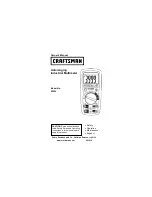
Input Impedance:
10M ohms on all ranges.
Frequency Range:
40Hz to 400 Hz
Overload Protection:
700V RMS or 1000V peak continuous on
AC ranges, except 200mV AC range
(15 sec. max. above 300V RMS).
SPECIFICATIONS
Accuracies are ± (% reading ± the number indicated in the
respective chart, added or deducted from the digit, or right hand
column of the reading)
AC Voltage
2mV
2V
20V
200V
700V
Range
Accuracy
Resolution
±0.8% of rdg ± 3 digits
±1.2% of rdg ± 3 digits
100µA
1mV
10mV
0.1V
1V
5
Input Impedance:
10M ohms on all ranges.
Overload Protection: 220V RMS on 200mV range and 1000V DCor
peak AC all others
± 0.8 of rdg ± 2 digit
200mV
2V
20V
200V
1000V
100µV
1mV
10mV
0.1V
1V
Range
Accuracy
Resolution
±0.5% of rdg ± 1 digit
DC Voltage
±1.2% of rdg ± 3 digits
1. Check the 9-volt battery by setting the ON-OFF switch to ON, if the
battery is weak, a + - sign will appear on the display. If this does not
appear on the display, proceed as below. See MAINTENANCE if the
battery has to be replaced.
2. The mark, or symbol, next to the test lead jacks, is a warning that the
input voltage or current should not exceed the indicated values, to
prevent damage to internal circuitry.
3. The function switch should be set to the range which you want to test
before operation.
DC Voltage Measurement
WARNING. Use extreme caution measuring high voltages, and do not
attempt to measure voltages greater than 1000 Volts, as this can
damage internal circuitry.
1. Connect the BLACK test lead to the COM jack and the RED test lead to
the V/
Ω
jack.
2. Set FUNCTION switch to V --- range to be used and connect test leads
across source or load. Reverse polarity is indicated by a “—” sign being
displayed in front of the reading.
Note:
1. If voltage range is not known beforehand, set the FUNCTION switch to a
high range and work down.
2. When only the figure “1” is displayed, over-range is being indicated,
and the FUNCTION switch must be set to a higher range.
AC Voltage Measurement
WARNING. Use extreme caution measuring high voltages, and do not
attempt to measure voltages greater than 700 Volts RMS, as this can
damage internal circuitry.
1. Connect the BLACK test lead to the COM jack and the RED test lead to
the V/
Ω
jack.
2. Set the FUNCTION switch to the V~ range to be used and connect the
test leads across the source or load under measurement.
Notes: See DC Voltage measurement Note 1.2.
OPERATION
8
Input Impedance:
10M ohms on all ranges.
Frequency Range:
40Hz to 400 Hz
Overload Protection:
700V RMS or 1000V peak continuous on
AC ranges, except 200mV AC range
(15 sec. max. above 300V RMS).
SPECIFICATIONS
Accuracies are ± (% reading ± the number indicated inh the
respective chart, added or dxceducted from the digit, or right
hand column of the reading)
AC Voltage
2mV
2V
20V
200V
700V
Range
Accuracy
Resolution
±0.8% of rdg ± 3 digits
±1.2% of rdg ± 3 digits
100µA
1mV
10mV
0.1V
1V
5
Input Impedance:
10M ohms on all ranges.
Overload Protection: 220V RMS on 200mV range and 1000V DCor
peak AC all others
± 0.8 of rdg ± 2 digit
200mV
2V
20V
200V
1000V
100µV
1mV
10mV
0.1V
1V
Range
Accuracy
Resolution
±0.5% of rdg ± 1 digit
DC Voltage
±1.2% of rdg ± 3 digits
1. Check the 9-volt battery by setting the ON-OFF switch to ON, if the
battery is weak, a + - sign will appear on the display. If this does not
appear on the display, proceed as below. See MAINTENANCE if the
battery has to be replaced.
2. The mark, or symbol, next to the test lead jacks, is a warning that the
input voltage or current should not exceed the indicated values, to
prevent damage to internal circuitry.
3. The function switch should be set to the range which you want to test
before operation.
DC Voltage Measurement
WARNING. Use extreme caution measuring high voltages, and do not
attempt to measure voltages greater than 1000 Volts, as this can
damage internal circuitry.
1. Connect the BLACK test lead to the COM jack and the RED test lead to
the V/
Ω
jack.
2. Set FUNCTION switch to V --- range to be used and connect test leads
across source or load. Reverse polarity is indicated by a “—” sign being
displayed in front of the reading.
Note:
1. If voltage range is not known beforehand, set the FUNCTION switch to a
high range and work down.
2. When only the figure “1” is displayed, over-range is being indicated,
and the FUNCTION switch must be set to a higher range.
AC Voltage Measurement
WARNING. Use extreme caution measuring high voltages, and do not
attempt to measure voltages greater than 700 Volts RMS, as this can
damage internal circuitry.
1. Connect the BLACK test lead to the COM jack and the RED test lead to
the V/
Ω
jack.
2. Set the FUNCTION switch to the V~ range to be used and connect the
test leads across the source or load under measurement.
Notes: See DC Voltage measurement Note 1.2.
OPERATION
8
























